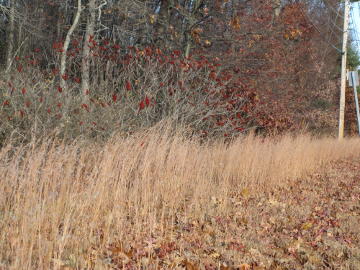

Little bluestem grass is one of the red colors in our autumn landscape, especially along local roads.
November 30, 2018, Page A8-A9
NATURE NOTES
By Annie Reid
Westborough Community Land Trust
Grass appreciation
Have you thought about grass recently? Or even appreciated it? Not the lawn you mow, and not the “grass” that’s being legalized (and is not in the grass family, Poaceae). instead, have you noticed the wild grasses that lend color and texture to our landscapes, especially in autumn? Little bluestem is one of the most common and noticeable wild grasses in our area.
You’re most likely to notice little bluestem (Schizachyrium scoparium, formerly Andropogon scoparius) along local roadsides at this time of year, although there’s nothing blue about it right now. It’s one of our beautiful autumn reds - the reddish-tan grass with masses of small feathery silver tufts, making a lovely sight in the sunlight. The reddish color lasts into the winter. The blue or blue-green color only appears when little bluestem starts coming up in early summer, when you’re unlikely to spot it among all the other greenery. It is considered a warm-season grass.
Little bluestem grows about knee- or waist-high. It’s native to North America and was abundant in the “mixed grass” prairie of the Midwest, originally found in the Dakotas, Nebraska, Kansas, Oklahoma, and parts of Texas - the area now covered with wheat crops. Around here you’ll see little bluestem in sunny, dry areas, where it tends to grow in clumps (and for this reason is called a bunchgrass). Look along roadsides or railroad tracks, or where trails pass through sunny, open areas, such as the Andrews Street entrance to the Headwaters Conservation Area in Westborough. (The trail map is http://www.westboroughcharm.org/guide/maps/hca_trail_map.pdf.)
Most of a grass plant is underground, in the extensive root system, rather than above ground in leaves, stems, and branches. Little bluestem has a deep, fibrous root system. The root system helps grasses survive dry conditions, as well as mowing, grazing, and fire. Also helpful is the fact that grasses grow from the part of the plant that’s close to the ground, not from the top or tips of the plant. Little bluestem grows from a point about an inch above the ground.
Little bluestem is often planted for erosion control. It adapts well to a variety of soil and moisture conditions. It’s also deer-resistant. It can withstand drought, heat, and cold. Commercial varieties have been developed for gardens and ornamental uses.
Little bluestem has benefits for wildlife. Its feathery tufts are attached to seeds, which are food for birds such as dark-eyed juncos (Junco hyemalis), chipping sparrows (Spizella passerina), field sparrows (Spizella pusilla), and tree sparrows (Spizelloides arborea). The plants are host plants - food and shelter - for butterfly caterpillars such as certain grass skippers, including crossline skippers (Polites origenes), dusted skippers (Atrytonopsis hianna), Indian skippers (Hesperia sassacus), and Leonard’s skippers (Hesperia leonardus).
On a larger scale, grasses provide food - protein, carbs, minerals – for humanity. Think of the most important ones: wheat, rye, corn, rice, oats, barley, sorghum, and millet.
Little bluestem is just one of many grasses that make up parts of our natural landscape. Not all are native. About 25% of the grass species in New England are non-native.
New England is basically a land of trees, but take some time to notice little bluestem and appreciate our wild grasses, even as winter approaches.
Date index
Month (November)
Common name index
Scientific name index
Category index